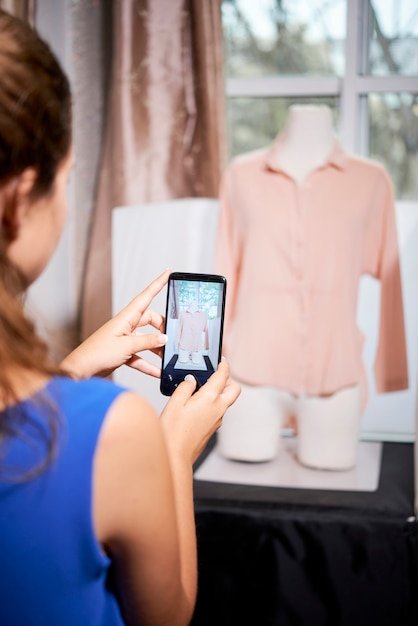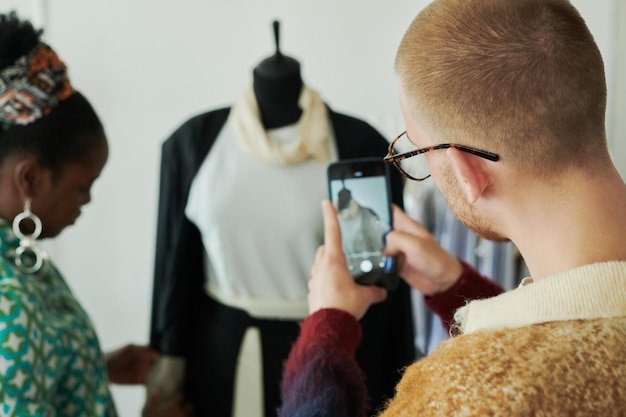AI-powered style guides are revolutionizing the US shopping experience by leveraging algorithms to predict individual fashion preferences and curate personalized recommendations, enhancing convenience and style discovery for consumers.
Are you ready to have your wardrobe predicted? AI-powered style guides are transforming how Americans shop, offering personalized fashion advice and predicting your next must-have items with uncanny accuracy.
How AI Is Revolutionizing Fashion in the US
Artificial intelligence is no longer just a futuristic concept; it’s actively reshaping industries, and fashion is no exception. In the United States, AI is being used to personalize shopping experiences, predict upcoming trends, and offer style advice tailored to individual preferences.
From virtual stylists to AI-driven recommendation engines, the impact of this technology is both significant and rapidly evolving.

Personalized Recommendations
One of the most notable ways AI enhances the fashion retail experience is through personalized recommendations. AI algorithms analyze user data, including past purchases, browsing history, and social media activity, to create detailed style profiles. These profiles are then used to suggest items that align with the user’s taste.
- Improved Accuracy: AI algorithms become more accurate over time as they gather more data.
- Increased Engagement: Personalized recommendations keep customers engaged.
- Higher Sales: By presenting customers with items they are likely to love, AI drives sales.
This level of personalization not only makes shopping more efficient but also helps customers discover new styles they might not have found otherwise.
The Rise of Virtual Stylists and Fashion Bots
Virtual stylists and fashion bots represent another significant advancement in AI-driven fashion. The platforms leverage AI to offer real-time fashion advice, style consultations, and even complete wardrobe makeovers.
These digital assistants are available 24/7, providing a convenient and accessible way for customers to get fashion tips and make informed purchasing decisions.
How Virtual Stylists Work
Virtual stylists use sophisticated algorithms to understand a user’s needs and preferences. Users typically start by answering a series of questions about their style, body type, and lifestyle. The AI then analyzes this information to generate personalized outfit recommendations.
Benefits of Fashion Bots
Fashion bots offer a range of benefits, including:
- Instant Advice: Get immediate style recommendations without waiting for a human stylist.
- Cost-Effectiveness: Virtual stylists are often more affordable than traditional stylists.
- Personalized Experience: AI tailors advice to your unique style and preferences.
Moreover, virtual stylists can integrate with e-commerce platforms, allowing users to purchase recommended items directly through the chat interface.

Predicting Fashion Trends With AI
In addition to personalizing individual shopping experiences, AI is also playing a crucial role in predicting broader fashion trends. AI algorithms analyze vast amounts of data from various sources, including social media, fashion blogs, and sales data, to identify emerging patterns and predict which styles will be popular in the future.
This capability is invaluable for retailers, designers, and marketers, allowing them to anticipate consumer demand and adjust their strategies accordingly.
Data Sources for Trend Prediction
AI algorithms rely on a variety of data sources to predict fashion trends, including:
- Social Media: Analyzing posts, hashtags, and images to identify trending styles.
- Fashion Blogs: Monitoring industry news, designer collections, and street style photos.
- Sales Data: Analyzing purchase patterns and inventory levels to understand demand.
By combining these data sources, AI can provide a comprehensive and accurate view of the fashion landscape.
Enhancing In-Store Shopping With AI
While e-commerce has seen significant advancements, AI is also enhancing the in-store shopping experience. Retailers are implementing AI-powered tools to improve customer service, optimize inventory management, and create more engaging shopping environments.
From smart mirrors to personalized recommendations, AI is transforming brick-and-mortar stores into high-tech fashion destinations.
Smart Mirrors and Virtual Try-Ons
Smart mirrors use augmented reality (AR) and AI to allow customers to virtually try on clothing without physically changing. These mirrors can also provide personalized style recommendations based on the items the customer is trying on.
Improved Inventory Management
AI can analyze sales data and customer behavior to optimize inventory management, ensuring that stores have the right products in stock at the right time. By reducing stockouts and minimizing excess inventory, AI helps retailers improve profitability and reduce waste.
This intelligent stocking process ensures customers find what they need, enhancing the overall shopping experience.
Ethical Considerations and Future of AI in Fashion
As AI becomes more deeply integrated into the fashion industry, it’s important to consider the ethical implications. Data privacy, algorithmic bias, and job displacement are some of the key concerns that need to be addressed.
Ensuring that AI is used responsibly and ethically is crucial for fostering trust and realizing the full potential of this technology.
Data Privacy
Collecting and using customer data raises privacy concerns. Retailers need to be transparent about how they collect and use data and provide customers with control over their information.
Algorithmic Bias
AI algorithms can perpetuate existing biases if they are trained on biased data. It’s important to ensure that algorithms are fair and equitable, avoiding discrimination.
By addressing these ethical concerns, the fashion industry can harness the power of AI while protecting the interests of consumers and workers.
Examples of Successful AI Implementation in US Fashion Retail
Several US fashion retailers are already leveraging AI to improve their operations, enhance the customer experience, and drive sales. These examples provide valuable insights into the various ways AI can be successfully implemented in fashion retail.
From personalized recommendations to AI-driven inventory management, these companies demonstrate the transformative potential of this technology.
Stitch Fix
Stitch Fix is a prime example of a company that has successfully integrated AI into its business model. The online personal styling service uses AI to analyze customer preferences and generate personalized outfit recommendations. This approach has helped Stitch Fix attract and retain a large customer base.
Nordstrom
Nordstrom is using AI to enhance the in-store shopping experience. The retailer has implemented smart mirrors and virtual try-on technologies in select stores to provide customers with personalized style advice and improve engagement.
These examples highlight the diverse ways AI can be used to create value in the fashion retail industry.
| Key Aspect | Brief Description |
|---|---|
| ✨ Personalized Recommendations | AI provides tailored fashion choices based on user data. |
| 🤖 Virtual Stylists | AI-driven bots offer real-time fashion advice and consultations. |
| 🔮 Trend Prediction | AI algorithms forecast upcoming fashion trends using diverse data sources. |
| 🛍️ In-Store Enhancements | AI improves shopping with smart mirrors and inventory management. |
Frequently Asked Questions
▼
▼
▼
▼
▼
Conclusion
AI-powered style guides are rapidly transforming the US fashion landscape, offering personalized recommendations, predicting trends, and enhancing both online and in-store shopping experiences. By understanding how AI is being used and addressing the associated ethical concerns, consumers and businesses can harness the power of this technology to create a more engaging, efficient, and sustainable fashion ecosystem.